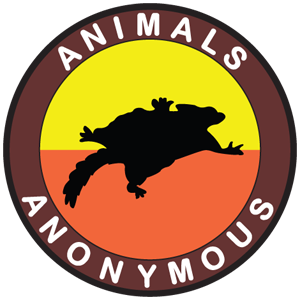CREATING A HABITAT GARDEN
Attracting Wildlife To Your Home
Nesting boxes and indigenous plants at Animals Anonymous.
The Adelaide and Mount Lofty Ranges is part of a Commonwealth Biodiversity Hotspot, one of 15 in Australia. That means that we have a very rich amount of plants and animal species. Around 70% of the land in Adelaide is private land, so by taking steps to encourage wildlife to live around our homes we can help protect our unique local biota.
This page aims to assist you to create your own wildlife habitat at home, at your school or anywhere else you choose to be suitable.
Habitat Garden showing a diversity of smaller plant species all indigenous to the Mount Lofty Ranges.
Are there health benefits from having a habitat garden:
Apart from all the potential benefits for the environment, habitat gardening can get you closer to nature. There are endless scientific studies available that show the health benefits from being in nature.
Some things to consider when selecting plants for your habitat garden:
Consider the size that a plant will eventually grow.
Do you require screening from the neighbours or from a road etc? Consider having a fire break around your house and other assets and consider using fire resistant plant species.
Consider the soil, sun, and slope of an area when selecting plant species.
What is already growing in your local area and is successful.
Larger plants (shrubs) can crowd out ground-covers and potential basking spots for reptiles.
Some species grow fast but may be short-lived. Some species grow slow and can be long-lived.
A diversity of plant species, sizes, flowering times etc equals a diversity of wildlife you might attract.
Choosing a locally indigenous plant species to your area is the best way to attract local wildlife as well as create a self propagating native system.
Ideally choose a locally indigenous plant species so that it may reproduce. If a non-indigenous species reproduces it may be at risk of becoming an environmental weed.
Learn about some of the science behind the benefits of connecting with the natural world with Dr. Cheryl Wilson.
A small habitat garden in a Sydney backyard. Photo credit: Benjamin Foster.
What plants are indigenous to my area?
Contact your local council, the good ones will provide you with a list of indigenous plants for your region.
Visit a native plant nursery such as State Fauna (Belair National Park, Murray Bridge) or Provenance Plants (Salisbury Park).
Purchase or borrow a plant field guide for you area (such as ‘It's Blue with Five Petals’, ‘Plants of the Adelaide Hills and Plains’, ‘Focus on Flora’).
If you have a bushland reserve near you, you might find a plant species list online that can be a guide.
Some of the remnant bushland at Animals Anonymous Headquarters in Mylor. Great seed bank for creating an indigenous habitat garden.
Habitat Garden in the Mount Lofty Ranges with a mixture of indigenous and non-indigenous natives. Photo credit: Steve Perkins.
Should I create a pond?
Ponds are an awesome addition for aquatic plants, inverts such as dragon flies, native fish and frogs. Permanent water is always popular for animals in the warmer months. Always give ponds tapering edges so they don't become death traps. Be careful not to suffocate the pond with species like bulrush that can take over. Ephemeral water sources are also necessary for the live cycles of some species such as the Bibron's Toadlet. Provide plants for fish, tadpoles, inverts etc to hide from predators and to provide shelter.
Our good friend frog researcher, Steve Walker, chatting about creating a habitat for frogs.
Should I install nesting boxes?
About one in three of Australia's terrestrial mammals are hollow-dependant.
Of our microbats about two out of three rely on hollows.
Around 15% of Australian birds are hollow dependant.
About one in six of Australia's birds are reliant on hollows.
Over 300 vertebrate species across Australia rely on hollows.
Tree hollows can take many decades and even hundreds of years to develop.
Nesting boxes can be bought or made to suite a target species but there are no guarantees
Species you might find using your nesting boxes:
· Owls
· Wood ducks
· Pardalotes
· Kookaburras
· Parrots such as rosellas
· Ring-tailed and brush-tailed possums
· Antechinus
· European honey-bees (boooooo)
Yellow-footed Antechinus with joeys using a nesting box at Animals Anonymous headquarters.
Adelaide Rosella nestling being fed by parent. Photo credit: Heather Badger.
Some Local wildlife you might attract to your habitat garden:
Mammals: possums, bats, native rats, antechinus, koalas, kangaroos, bandicoots, echidnas.
Birds: Honey eaters, insect eaters, seed eaters, raptors etc.
Reptiles: small-medium skinks, blue-tongue skinks, bearded dragons, marbled geckos, barking geckos, snakes.
Frogs: brown tree, spotted marsh, common froglet, bibron's toadlet, eastern banjo.
Invertebrates: butterflies, moths, mantids, beetles, bugs, dragonflies, native bees, flies, etc. Consider the life-cycle of the invertebrate for example, is it aquatic, a burrower or a borer at some stage of its life.
Check out the interview we did with biologist James Smith about ways to attract wildlife to your property. James owns a business called fauNature where he and his team make nesting boxes for a wide range of Australian fauna. James is also the author of the book, Wildlife of Greater Adelaide, the most comprehensive wildlife guide to the Greater Adelaide region.
Have a listen to the chat we had with habitat creation expert Ross Oke for more ideas to attract wildlife to your property.
Habitat Garden with a diversity of native plants, a mulch substrate and rocks for reptiles to bask. Photo credit: Emma Timmins.
Bibron’s Toadlet. Near Threatened frog species in the Mount Lofty Ranges.









